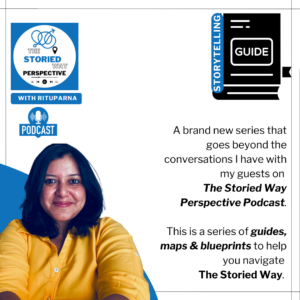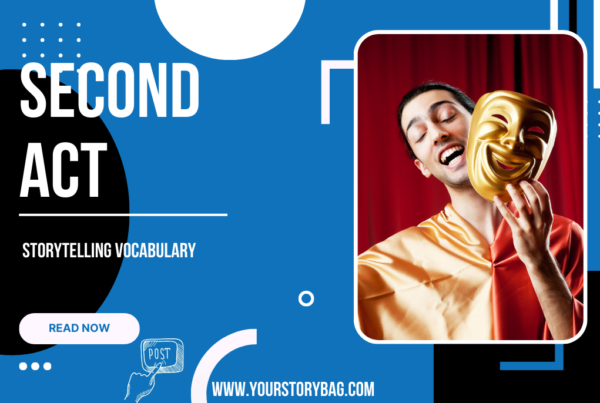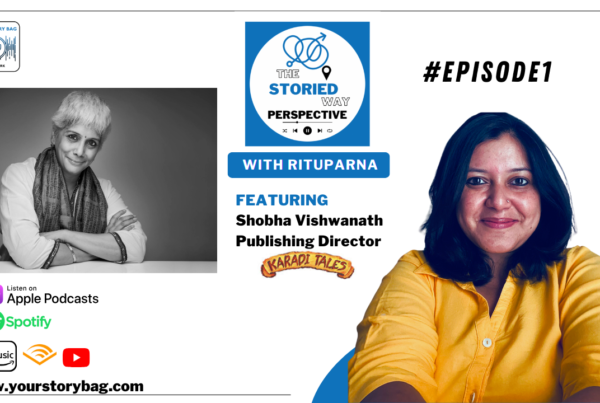“Rituparna, you make storytelling look so easy. It’s a lot tougher for us. We are not as articulate as you. How can we find stories to tell?” remarked a senior leader at an IT company to me.
He was the one who had sanctioned my workshop. He stepped in sometime midway and chose to stay till the end.
I always anticipate this question. I always have my answer ready.
During my recent conversation with Janaki Sabesh on The Storied Way Perspective, I asked her, “How do you bring out the storyteller in your audience when they are so convinced that they are not the storyteller in the room?”
I was looking to learn from Janaki’s bag of strategies and techniques, of course! After all, that’s what my podcast lets me do. It opens doorways to learn from fellow storytellers. So it was a pleasant surprise, when I realised that for both of us, the starting line to storytelling begins at home!
Janaki replied, “I asked them to just share simple things like, know, activity, like what was that one thing that connected them with, say, their child or their first teacher?”
That’s a simple prompt, potent enough to unlock impactful storytelling in even the most hesitant individuals.
Here is an excerpt of our conversation –
We often separate our professional selves from our personal experiences. But what if the key to better leadership, stronger teams, and more effective communication lies in the stories we carry with us? After all, walking into office shouldn’t mean leaving your authentic self behind.
So let that be a soft beginning to the reluctant storyteller in you. The best stories are the ones you own, the ones you have lived and experienced first hand. Once you are comfortable with personal anecdotes, you can pivot them to business settings.
Personal anecdotes, when used intentionally, can:
🔹 Make leadership more relatable – A manager who shares a moment of failure, learning or transparency builds trust with their team.
🔹 Enable Knowledge Sharing – Bring diverse teams together to share their workplace stories of collaborations, problem solving and innovations. Similarly past experiences / learnings and insights can make for rich knowledge sharing sessions.
🔹 Enhance presentations and pitches – A personal story makes data-driven arguments more engaging and memorable. How close are YOU to the problem or the stakeholders whose lives you are changing? Make their story your own.
🔹 Strengthen workplace relationships – Sharing small, meaningful experiences fosters deeper connections and collaboration. Make water cooler conversations cooler, gather around for an evening of collaborative stories. Take time off, to find values that make you work together.
🔹 Improve problem-solving – A well-told personal story can help shift perspectives and drive innovative thinking. Stories that address change, conflict or challenges, automatically fire up the problem solving neurons in our brains.
The best part? These stories don’t have to be grand or extraordinary. They just have to be real.
Here is a 3-step guide to find ordinary stories and make them extraordinary by a strategic use.
Step 1: Identify When to Share a Story
Think about the purpose of your anecdote. Ask yourself:
✔ Why am I telling this story? Why now? Will this help explain a concept, inspire action, or resolve a challenge?
✔ Is it relevant to the team, project, or discussion?
✔ Will it foster connection and trust?
Step 2: Keep It Short & Structured
Anecdotes should be brief—no more than 2-3 minutes. Use this simple framework:
1️⃣ Context – Set the scene (Where, When, Who).
2️⃣ Situation – What was the problem or moment of change?
3️⃣ Outcome & Relevance – How was it resolved? How were you impacted by the end of the story? Why is the story still relevant to you?
Step 3: Connect the Story to the Workplace
After sharing your anecdote, bridge it back to the workplace by asking:
💡 Invite reflection & reaction from the listener
💡 Ask for a story
💡 Bridge the experience, learnings and insights to find commonalities.
Next time you step into a meeting, a presentation, or a one-on-one conversation—ask yourself: What personal experience can I use to make my message stronger?
Here are 5 story-prompts from 365 Days 365 Stories to help you get started on your journey:
[These are heart-crafted story prompts to help you find joy, reflection and mindfulness through storytelling]“Steps” – Think of it like a ladder, a stairway, or the actions you took to go closer to what you wanted. Share a story.
“City” – Tell us of a city that has influenced you. It could be the city Your grew up in, traveled to, or worked in.
“Learning” – How or what taught you the value of learning? Share a story today.
“Opponent” – We all remember our opponents. Share a story about a opponent who inspired you.
“Negotiate” – As humans we are always negotiation with something, someone or even ourselves. Tell one negotiation story.
Each of these personal stories can be further contextualised to suit conversation at the workplaces:
1. “Steps” – Small Actions That Lead to Growth
- Talk about a time you took small but important steps toward improvement.
- Share how you learned a new skill, adapted to a new role, or navigated a challenge.
- Helps show that progress isn’t always about big leaps—it’s about consistent effort.
📌 Example: “I used to struggle with writing reports. I took small steps—observing colleagues, asking for feedback, and practicing. Now, I write confidently.”
2. “City” – A Place That Shaped You
- Share how a city (where you grew up, traveled, or worked) shaped your work ethic, mindset, or adaptability.
- Connect it to a workplace value— celebrate diversity, teamwork, resilience, or creativity.
- Great for team-building discussions and getting to know colleagues better.
📌 Example: “Moving from a small town to a big city taught me to speak up and adapt quickly—skills that help me in fast-paced projects today.”
3. “Far from Perfect” – Learning from Imperfection
- Talk about a time when you made a mistake but turned it into a learning moment. Invite listeners to make mistakes.
- Encourages honest conversations about growth and improvement.
- Shows that perfection isn’t the goal—learning and adapting are.
📌 Example: “I once sent an email to the wrong client. At first I panicked. Then I owned up, fixed the issue, and learned to double-check everything.”
4. “Opponent” – A Rival Who Pushed You to Improve
- Reflect on a colleague, peer, or situation that challenged you to work harder or think differently.
- Helps shift the perspective of competition from conflict to motivation.
- Can be about a challenging teammate, a tough project, or even self-doubt.
📌 Example: “A teammate always seemed one step ahead of me in problem-solving. I was struggling to catch up. So one fine day, I decided to speak to them and learn from them.”
5. “Negotiate” – Finding a Middle Ground
- Share a time you had to negotiate—whether it was a deadline, a task, or even a personal work-life balance decision.
- Demonstrates the power of communication, compromise, and strategy.
- Helps teams see that negotiation happens at all levels, not just in leadership roles.
📌 Example: “I had too many tasks and felt overwhelmed. I negotiated with my manager to prioritise urgent work, and we found a balance that worked for both of us.”

I hope you enjoyed this quick Storytelling Guide on using Using Personal Narratives at the Workplace?
This is the first of our series of guides, maps & blueprints to help you navigate The Storied Way.
This series builds on the conversations I have with my guests on The Storied Way Perspective Podcast.
Tell me what you think of it?






